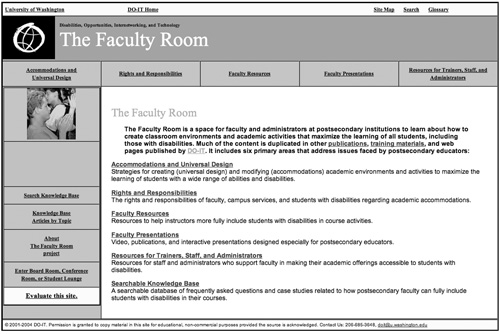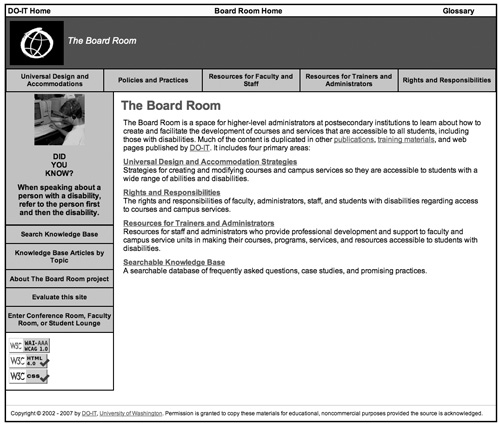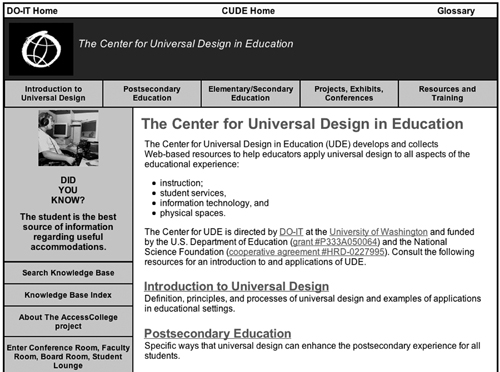Overhead Visuals
Following are examples of templates that can be used in creating overhead visuals for a Capacity-Building Institute (CBI). Many more options can be found in the following publications:
- Building the Team: Faculty, Staff, and Students Working Together—PRESENTATION AND RESOURCE MATERIALS
www.washington.edu/doit/building-team-faculty-staff-and-students-working-together-1 - Students with Disabilities and Campus Services: Building the Team—PRESENTATION AND RESOURCE MATERIALS
www.washington.edu/doit/students-disabilities-and-campus-services-building-team
Visual #1
Universal Design in Education: From Principles to Practice
https://www.washington.edu/doit/universal-design-education-principles-and-applications
Visual #2
Universal Design of Learning
Universal Design of Instruction
Universal Design of Technology
Universal Design of Facilities
Universal Design of Student Services
Visual #3
Key Resources
Select "AccessCollege" from the DO-IT website at
www.washington.edu/doit
for
- The Faculty Room
- The Conference Room
- The Board Room
- The Student Lounge
- The Center for Universal Design in Education
Visual #4
Section 504 of the Rehabilitation Act of 1973
"No otherwise qualified individual with a disability shall, solely by reason of his/her disability, be excluded from the participation in, be denied the benefits of, or be subjected to discrimination under any program or activity of a public entity."
Visual #5
"Otherwise qualified"
meets the academic and technical standards requisite to admission or participation
with or without
- reasonable modifications to rules, policies, or practices
- removal of architectural, communication, or transportation barriers
- provision of auxiliary aids and services.
Visual #6
"Person with a disability"
is any person who:
- has a physical or mental impairment which substantially limits one or more major life activities including walking, seeing, hearing, speaking, breathing, learning, and working
- has a record of such an impairment
- is regarded as having such an impairment
Visual #7
Examples of Disabilities
- Low Vision
- Blindness
- Hearing Impairments
- Mobility Impairments
- Mental Health/Psychiatric Impairments
- Health Impairments
- Learning Disabilities
Visual #8
Access Challenges
- Physical Differences
- Sensory Differences
- Cognitive/Learning Differences
- Attention Differences
- Communication Differences
- Differences in Socioeconomic Status, Race, Culture, Gender
Visual #9
Approaches to Access:
- Accommodations (reactive)
- Universal Design (proactive)
Visual #10
Accommodations
Alternate formats, services, adjustments, & technology for specific students
Visual #11
Universal Design =
"The design of products and environments to be usable by all people, without the need for adaptation or specialized design."
Center for Universal Design, North Carolina State University
Visual #12
Diversity in Postsecondary Institutions
- Ethnic/Racial Minorities
- English as a Second Language
- Different Learning Styles
- People with Disabilities
- Age, Gender Differences
Visual #13
Principles of Universal Design
- Equitable Use
- Flexibility in Use
- Simple and Intuitive Use
- Perceptible Information
- Tolerance for Error
- Low Physical Effort
- Size and Shape for Approach and Use
Visual #14
UD is not:
- just beneficial to people with disabilities
- about lowering standards
- about one-size-fits-all
- UD can be applied incrementally
Visual #15
UD Products/Environments:
- are flexible enough to be directly used (without assistive technologies, modifications) by people with a wide range of abilities and circumstances
- are compatible with assistive technologies and other accommodations for those who cannot efficiently access/use the products/environments directly
Visual #16
UD Steps
- Identify application.
- Define universe.
- Involve consumers.
- Adopt guidelines/standards/performance indicators.
- Apply UD guidelines/standards/performance indicators.
- Plan for accommodations.
- Train & support.
- Evaluate.
www.washington.edu/doit/universal-design-process-principles-and-applications
Visual #17
Universal Design in Education (UDE) can be applied to:
- Instruction
- Student Services
- Information Technology
- Physical Spaces
Visual #18
UD of IT
- Computers
- Software
- Websites
- Videos
- Office Equipment
- ...
Visual #19
UD of Computer Labs
- Planning, Policies, and Evaluation
- Facility and Environment
- Lab Staff
- Information Resources
- Computer, Software, and Assistive Technology
www.washington.edu/doit/equal-access-universal-design-computer-labs
Visual #20
Problem → Solution
Access to computers → Assistive technology (AT)
Access to electronic design → Universal resources
Visual #21
UD Video/Multimedia Presentation:
- is videotaped with captions in mind
- has large, clear captions
- is designed so that key content is spoken as well as demonstrated visually
- has audio-described version available
Visual #22
UD of Instruction Steps
- Identify course.
- Define universe.
- Select instructional strategies for good practice.
- Adopt guidelines/performance indicators.
- Apply UD guidelines/standards/performance indicators.
- Plan for accommodations.
- Evaluate.
www.washington.edu/doit/equal-access-universal-design-instruction
Visual #23
UD of Instruction
- Class Climate
- Physical Environments/Products
- Delivery Methods
- Information Resources/Technology
- Interaction
- Feedback
- Assessment
- Accommodation
www.washington.edu/doit/equal-access-universal-design-instruction
Visual #24
UDI Examples
- Put a statement on your syllabus inviting students to meet with you to discuss disability-related accommodations and other learning needs.
- Use multiple modes to deliver content (e.g., lecture, discussion, hands-on activities, Internet-based interaction, and fieldwork).
- Provide class outlines and notes on an accessible website.
- Face the class and speak clearly.
- Use captioned videos.
- Assess student learning using multiple methods.
Visual #25
UD of Curriculum
provides multiple means of:
- Representation
- Expression
- Engagement
Visual #26
UD of Student Services
- Planning, Policies, & Evaluation
- Physical Environments/Products
- Staff Information Resources/Technology
- Events
www.washington.edu/doit/equal-access-universal-design-student-services
Visual #27
UD of instruction, curriculum, student services, technology, physical spaces
minimizes
the need for assistive technology & other accommodations.
Visual #28
There is a need for both:
- Universal Design (proactive)
- Accommodations (reactive)
Visual #29
A Fully Accessible Postsecondary Institution
Visual #30
Assure access to:
- physical spaces
- computers
- information resources (e.g., publications, videos, websites)
- events
- on-site learning
- distance learning
- student services
Visual #31
Address issues related to:
- procurement
- development
- use
and
- policies
- procedures
- training/support
Visual #32
UD Impact on Roles
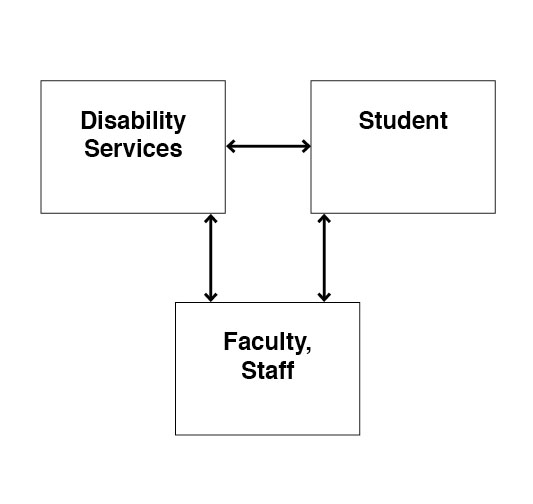
Visual #33
Campus Accessibility Indicators
1. Institution-level mission, vision, and values statements are inclusive of all people, including those with disabilities.
https://www.washington.edu/doit/accesscollege-systemic-change-postsecondary-institutions
Visual #34
Campus Accessibility Indicators
2. Disability is included in campus discussions of and training on diversity and special populations.
https://www.washington.edu/doit/accesscollege-systemic-change-postsecondary-institutions
Visual #35
Campus Accessibility Indicators
3. Policies, procedures, and practices are regularly reviewed for barrier removal and inclusivity of people with a diverse range of characteristics, including disability.
https://www.washington.edu/doit/accesscollege-systemic-change-postsecondary-institutions
Visual #35
Campus Accessibility Indicators
3. Policies, procedures, and practices are regularly reviewed for barrier removal and inclusivity of people with a diverse range of characteristics, including disability.
https://www.washington.edu/doit/accesscollege-systemic-change-postsecondary-institutions
Visual #36
Campus Accessibility Indicators
4. Administrators, staff, faculty, and student leaders are trained and empowered to take action around disability and universal design issues.
https://www.washington.edu/doit/accesscollege-systemic-change-postsecondary-institutions
Visual #37
Campus Accessibility Indicators
5. People with disabilities are visible (even if their disabilities are not) on campus including in positions of power and authority (e.g., administrators, faculty, student leaders).
https://www.washington.edu/doit/accesscollege-systemic-change-postsecondary-institutions
Visual #38
Campus Accessibility Indicators
6. Budgeting reflects the reality of the cost of applying universal design and of accommodating current and prospective employees, students, and visitors with disabilities.
https://www.washington.edu/doit/accesscollege-systemic-change-postsecondary-institutions
Visual #39
Campus Accessibility Indicators
7. Measures of student success (e.g., retention, course completion, graduation) are the same for all student populations, including students with disabilities, and institutional research includes this data.
https://www.washington.edu/doit/accesscollege-systemic-change-postsecondary-institutions
Visual #40
Campus Accessibility Indicators
8. Campus publications, websites, marketing, and public relations include images and content related to disabilities.
https://www.washington.edu/doit/accesscollege-systemic-change-postsecondary-institutions
Visual #41
Campus Accessibility Indicators
9. Campus publications and websites, including web-based courses, meet established accessibility standards.
https://www.washington.edu/doit/accesscollege-systemic-change-postsecondary-institutions
Visual #42
Campus Accessibility Indicators
10. Disability issues are regularly included as a component of the curriculum.
https://www.washington.edu/doit/accesscollege-systemic-change-postsecondary-institutions
Visual #43
Campus Accessibility Indicators
11. All campus facilities and other spaces are physically accessible.
https://www.washington.edu/doit/accesscollege-systemic-change-postsecondary-institutions
Visual #44
Visual #45
The Student Services Conference Room
https://www.washington.edu/doit/distance-learning-course-serving-students-disabilities
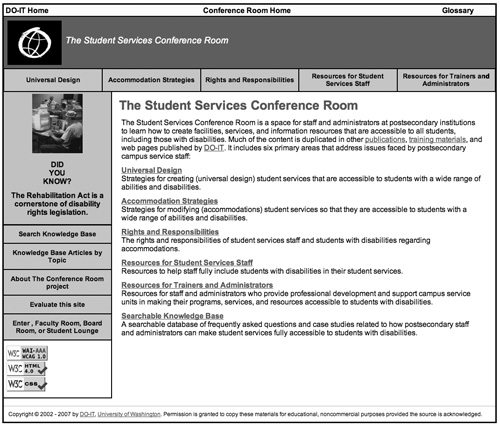
Visual #46
Visual #47
The Center for UD in Education
https://www.washington.edu/doit/programs/center-universal-design-education/overview
